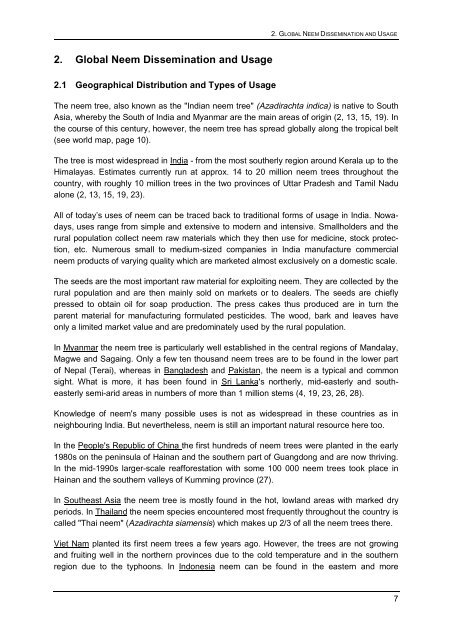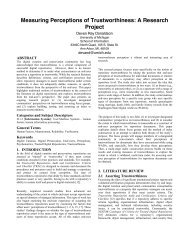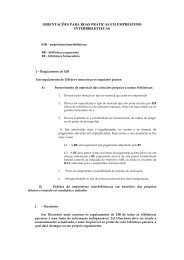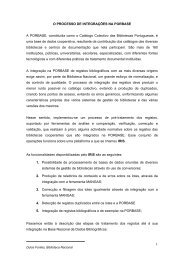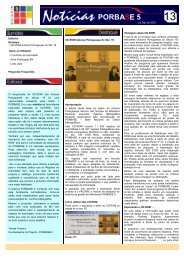Status report on global Neem usage - Biblioteca Nacional de Portugal
Status report on global Neem usage - Biblioteca Nacional de Portugal
Status report on global Neem usage - Biblioteca Nacional de Portugal
You also want an ePaper? Increase the reach of your titles
YUMPU automatically turns print PDFs into web optimized ePapers that Google loves.
2. Global <strong>Neem</strong> Disseminati<strong>on</strong> and Usage<br />
2.1 Geographical Distributi<strong>on</strong> and Types of Usage<br />
2. GLOBAL NEEM DISSEMINATION AND USAGE<br />
The neem tree, also known as the "Indian neem tree" (Azadirachta indica) is native to South<br />
Asia, whereby the South of India and Myanmar are the main areas of origin (2, 13, 15, 19). In<br />
the course of this century, however, the neem tree has spread <strong>global</strong>ly al<strong>on</strong>g the tropical belt<br />
(see world map, page 10).<br />
The tree is most wi<strong>de</strong>spread in India - from the most southerly regi<strong>on</strong> around Kerala up to the<br />
Himalayas. Estimates currently run at approx. 14 to 20 milli<strong>on</strong> neem trees throughout the<br />
country, with roughly 10 milli<strong>on</strong> trees in the two provinces of Uttar Pra<strong>de</strong>sh and Tamil Nadu<br />
al<strong>on</strong>e (2, 13, 15, 19, 23).<br />
All of today’s uses of neem can be traced back to traditi<strong>on</strong>al forms of <strong>usage</strong> in India. Nowadays,<br />
uses range from simple and extensive to mo<strong>de</strong>rn and intensive. Smallhol<strong>de</strong>rs and the<br />
rural populati<strong>on</strong> collect neem raw materials which they then use for medicine, stock protecti<strong>on</strong>,<br />
etc. Numerous small to medium-sized companies in India manufacture commercial<br />
neem products of varying quality which are marketed almost exclusively <strong>on</strong> a domestic scale.<br />
The seeds are the most important raw material for exploiting neem. They are collected by the<br />
rural populati<strong>on</strong> and are then mainly sold <strong>on</strong> markets or to <strong>de</strong>alers. The seeds are chiefly<br />
pressed to obtain oil for soap producti<strong>on</strong>. The press cakes thus produced are in turn the<br />
parent material for manufacturing formulated pestici<strong>de</strong>s. The wood, bark and leaves have<br />
<strong>on</strong>ly a limited market value and are predominately used by the rural populati<strong>on</strong>.<br />
In Myanmar the neem tree is particularly well established in the central regi<strong>on</strong>s of Mandalay,<br />
Magwe and Sagaing. Only a few ten thousand neem trees are to be found in the lower part<br />
of Nepal (Terai), whereas in Bangla<strong>de</strong>sh and Pakistan, the neem is a typical and comm<strong>on</strong><br />
sight. What is more, it has been found in Sri Lanka's northerly, mid-easterly and southeasterly<br />
semi-arid areas in numbers of more than 1 milli<strong>on</strong> stems (4, 19, 23, 26, 28).<br />
Knowledge of neem's many possible uses is not as wi<strong>de</strong>spread in these countries as in<br />
neighbouring India. But nevertheless, neem is still an important natural resource here too.<br />
In the People's Republic of China the first hundreds of neem trees were planted in the early<br />
1980s <strong>on</strong> the peninsula of Hainan and the southern part of Guangd<strong>on</strong>g and are now thriving.<br />
In the mid-1990s larger-scale reafforestati<strong>on</strong> with some 100 000 neem trees took place in<br />
Hainan and the southern valleys of Kumming province (27).<br />
In Southeast Asia the neem tree is mostly found in the hot, lowland areas with marked dry<br />
periods. In Thailand the neem species encountered most frequently throughout the country is<br />
called "Thai neem" (Azadirachta siamensis) which makes up 2/3 of all the neem trees there.<br />
Viet Nam planted its first neem trees a few years ago. However, the trees are not growing<br />
and fruiting well in the northern provinces due to the cold temperature and in the southern<br />
regi<strong>on</strong> due to the typho<strong>on</strong>s. In Ind<strong>on</strong>esia neem can be found in the eastern and more<br />
7


